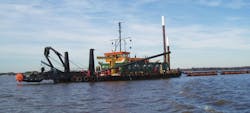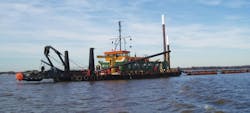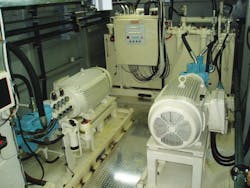Hydraulics runs dredger 24/7
Cottrell Contracting, Chesapeake, Va., has performed both shallow and deep water projects throughout its 80-year history. The company can pump sand from any inland site to be placed on a beach up to 8 mi away. Cottrell’s dredge Lexington is built to American Bureau of Shipping standards to operate in an ocean environment to mine sand from either inland or offshore sites.
“The hydraulic method of dredging and material transport,” pointed out Jimmy Cottrell, vice president of Cottrell Contracting, “has been around forever. Our success is that we have been able to stay on the cutting edge of the technology to upgrade old systems to ones that are more precise and efficient.”
Reliability and longevity
“Our dredge Lexington has been in service for seven years doing maintenance and navigation dredging along the Atlantic Intercoastal Waterway for most eastern seaboard deep water ports and harbors. Able to dredge down to 65 ft, the Lexington uses a suction cutter and piping system to excavate sand, mud, and hard packed clay,” Cottrell continued. “All this is done hydraulically, where the cutter head cuts the material that is then conveyed through a 2000-hp centrifugal pump and pipeline system that can extend 20,000 ft, and with no need for additional pumps. Depending on the specific gravity of the material being dredged and pumped, we have additional pumps that can be put in the pipeline as needed.
“Accurate positioning of the dredge within the cut is important because we only get paid by material that is within the pay template. The torque demand is massive. In effect, dredging is the equivalent of the demand in the mining industry that requires the greatest safety factors because the entire system is always under strenuous load. Dredge Lexington operates 24/7, 362 days a year. The only three days off are for the Christmas holiday” Cottrel noted.
The hydraulic system is powered by Parker Hannifin Gold Cup and Premier tandem pumps. A P30S Gold Cup pump drives the cutter head’s hydraulic motor in a system designed to extend the life of cutting teeth. Cottrell revealed, “The suction cutter’s P30S Gold Cup pump worked continuously for six years before a replacement was needed. Recently, we had two Parker Premier swing winch pumps inspected, and they showed very little wear.”
Parker P16 and P12 tandem pumps, located in Lexington’s main hydraulic power unit, drive winches, a spud system, and anchors and carrier. Cottrell continued, “We control and manipulate winches that swing the dredge back and forth from side to side and raise and lower a dredging ladder with the suction cutter — a combined weight of 83 tons.” The tandem pumps also drive two 30-in. diameter, 83-ft long spuds that are raised and lowered by hydraulic cylinders to accurately position the dredge within the cut.
“Summed up, the hydraulic system we’re using has been precise in swinging the machine and moving within the cut we’re trying to dredge. By nature, dredging is an inexact science, but we are able to concentrate on moving the material we get paid for more economically.
“A big contributor to part of our cost success with our customers is that we only handle the material one time: we cut it and it goes through the pipeline to the deposal site,” Cottrell said. “Unlike bucket dredging, we don‘t have to handle the material twice by putting it on a hopper dredge or scow and then carry it to another site and off load it. That’s very inefficient.
“Prior to designing, building and launching dredge Lexington, our work with our three other dredges was limited to shallow draft projects. They are electric-based and work through pinions, gears and clutches. Hence, the control is not as great. With the Lexington, we have been able to do very precise work in a whole new deepwater market that has given us many more chances at success – the ability to cost effectively dredge deepwater harbors, aircraft carrier piers and nuclear submarine bases,” Cottrell concluded.
Click here for more information on Parker‘s P series Gold Cup pumps.




